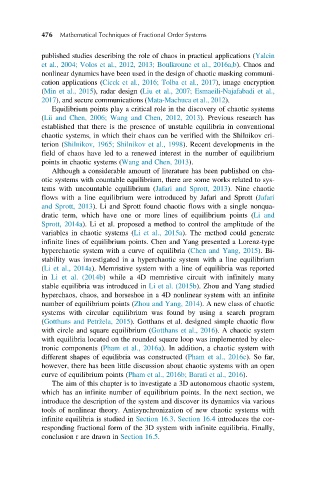Page 489 - Mathematical Techniques of Fractional Order Systems
P. 489
476 Mathematical Techniques of Fractional Order Systems
published studies describing the role of chaos in practical applications (Yalcin
et al., 2004; Volos et al., 2012, 2013; Boulkroune et al., 2016a,b). Chaos and
nonlinear dynamics have been used in the design of chaotic masking communi-
cation applications (Cicek et al., 2016; Tolba et al., 2017), image encryption
(Min et al., 2015), radar design (Liu et al., 2007; Esmaeili-Najafabadi et al.,
2017), and secure communications (Mata-Machuca et al., 2012).
Equilibrium points play a critical role in the discovery of chaotic systems
(Lu ¨ and Chen, 2006; Wang and Chen, 2012, 2013). Previous research has
established that there is the presence of unstable equilibria in conventional
chaotic systems, in which their chaos can be verified with the Shilnikov cri-
terion (Shilnikov, 1965; Shilnikov et al., 1998). Recent developments in the
field of chaos have led to a renewed interest in the number of equilibrium
points in chaotic systems (Wang and Chen, 2013).
Although a considerable amount of literature has been published on cha-
otic systems with countable equilibrium, there are some works related to sys-
tems with uncountable equilibrium (Jafari and Sprott, 2013). Nine chaotic
flows with a line equilibrium were introduced by Jafari and Sprott (Jafari
and Sprott, 2013). Li and Sprott found chaotic flows with a single nonqua-
dratic term, which have one or more lines of equilibrium points (Li and
Sprott, 2014a). Li et al. proposed a method to control the amplitude of the
variables in chaotic systems (Li et al., 2015a). The method could generate
infinite lines of equilibrium points. Chen and Yang presented a Lorenz-type
hyperchaotic system with a curve of equilibria (Chen and Yang, 2015). Bi-
stability was investigated in a hyperchaotic system with a line equilibrium
(Li et al., 2014a). Memristive system with a line of equilibria was reported
in Li et al. (2014b) while a 4D memristive circuit with infinitely many
stable equilibria was introduced in Li et al. (2015b). Zhou and Yang studied
hyperchaos, chaos, and horseshoe in a 4D nonlinear system with an infinite
number of equilibrium points (Zhou and Yang, 2014). A new class of chaotic
systems with circular equilibrium was found by using a search program
(Gotthans and Petrˇ zela, 2015). Gotthans et al. designed simple chaotic flow
with circle and square equilibrium (Gotthans et al., 2016). A chaotic system
with equilibria located on the rounded square loop was implemented by elec-
tronic components (Pham et al., 2016a). In addition, a chaotic system with
different shapes of equilibria was constructed (Pham et al., 2016c). So far,
however, there has been little discussion about chaotic systems with an open
curve of equilibrium points (Pham et al., 2016b; Barati et al., 2016).
The aim of this chapter is to investigate a 3D autonomous chaotic system,
which has an infinite number of equilibrium points. In the next section, we
introduce the description of the system and discover its dynamics via various
tools of nonlinear theory. Antisynchronization of new chaotic systems with
infinite equilibria is studied in Section 16.3. Section 16.4 introduces the cor-
responding fractional form of the 3D system with infinite equilibria. Finally,
conclusion r are drawn in Section 16.5.

